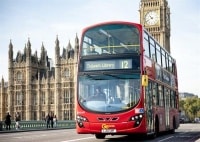The proposed levy, on top of the existing congestion charge, forms part of London Mayor Boris Johnson’s so-called air quality manifesto, which is due to be launched this evening, July 29, 2014.
Diesel vehicles that meet the Euro 6 emissions standard will be exempt from the charge.
In a speech to be delivered at Mansion House, Johnson is expected to set out how City Hall, the headquarters of the Greater London Authority, will take London two thirds of the way to compliance with EU NO2 limits by 2020.
This will be achieved in part with the introduction of an Ultra Low Emission Zone (ULEZ), which aims to encourage ultra low or zero emission driving by 2020.
Additionally, Johnson will call on the government to ‘put air quality at the heart of health, energy and climate change policies’; and ask the European Commission to improve the testing of new engine emission standards, plus create a new fund to help European cities tackle pollution.
Working with the government’s Office for Low Emission Vehicles, Johnson wants to transform London’s vehicle fleets, delivering 200,000 ultra-low emission cars, 7,000 zero emission taxis, 11,500 ultra-low emission private hire vehicles, an additional 1,600 zero emission buses, and up to 350 electric vehicles in other public fleets. By 2020 London will have 35 rapid charging hubs with 350 rapid charge points and an inductive charging network.
As an immediate measure, the Mayor will today announce the retrofit of a further 400 of TfL’s older buses as well as plans to expand the electric bus fleet by a minimum of 300 by 2020.
‘This manifesto will be key in encouraging the use of cleaner, greener fuels to reduce air pollution and protect the nation’s health,’ said Diana Raine, European business manager, Hydrogen Energy Systems at Air Products ‘Forecasts by UK H2Mobility show that a mix of hydrogen production methods can deliver hydrogen to the driver at a cost competitive with diesel, yet with 60 per cent lower CO2 emissions in 2020, 75 per cent lower in 2030 and on a path to zero-carbon by 2050, making it the ideal replacement.’

In a separate development, GKN and the Go-Ahead Group have announced a deal that will see 500 Gyrodrive systems installed into Go-Ahead’s buses over the next two years.
Gyrodrive uses a high speed flywheel made of carbon fibre to store the energy generated as the bus slows down, which then generates electricity used by an electric motor to help the diesel engine drive the bus. It is claimed that the system generates fuel savings of more than 20 per cent at a significantly lower cost than battery hybrid alternatives.
The agreement covers the supply of the complete Gyrodrive system, including the GKN Hybrid Power flywheel as well as GKN’s EVO electric motor, a GKN designed and manufactured gearbox, plus installation.
Following successful trials, Go-Ahead intends to utilise the technology in cities it serves across the UK, initially in London and Oxford.
Is London Mayor Boris Johnson right to push for a £10 levy on polluting vehicles from 2020? Let us know by taking part in our latest Poll or by leaving a comment here.




Report highlights significant impact of manufacturing on UK economy
Note to Evil Villain/Dave 2020. Thatcher was PM for _11_ years, from 1979 to 1990 so no one under the age of 34 was even born when she left office....